Gainward FX Powerpack Ultra/1200 Golden Sample Video Card on NVIDIA GeForce
FX 5900, Performance in NEW Game Tests and the FX 5900 without "Optimizations"
|
CONTENTS
Since production cards based on NVIDIA's fastest processor GeForce FX 5900
Ultra have only started penetrating into the market, we will focus on a bit less
powerful cards based on the FX 5900.
We are well aware that in the game tests the FX 5900 has equal scores with
the ATI RADEON 9800 PRO. Also, we know that both ATI and NVIDIA succeed in making
cheats in both FutureMark packets: 3DMark2001 and 3DMark03. In the list below
all these issues are discussed:
Theoretical materials and reviews of video cards which concern functional
properties of the GPU NVIDIA GeForce FX
- Analysis of the architecture of NVIDIA NV30
(GeForce FX)
- NVIDIA GeForce FX 5800 Ultra (NV30)
- single-page review
- NVIDIA GeForce FX 5800 Ultra (NV30)
- multi-page review
- NVIDIA GeForce FX 5600 Ultra (NV31) and
GeForce FX 5200 Ultra (NV34) - single-page review
- NVIDIA GeForce FX 5600 Ultra (NV31) and
GeForce FX 5200 Ultra (NV34) - multi-page review
- ASUS V9900 Ultra on NVIDIA GeForce FX
5800 Ultra - AA and anisotropy quality
- Gainward FX Powerpack Ultra/1000 Golden
Sample and Gainward FX Powerpack Pro/660 TV/DVI on NVIDIA GeForce FX 5800 Ultra
and 5200 - scaling (performance vs. CPU clock speed) of GeForce FX 5800 Ultra,
performance of GeForce FX 5200
- Leadtek WinFast A300 Ultra MyVIVO on
NVIDIA GeForce FX 5800 Ultra - performance of GeForce FX 5800 Ultra vs. CPU
clock speed in heavy modes with AA and anisotropy enabled
- MSI FX5800 Ultra-TD8X on NVIDIA GeForce
FX 5800 Ultra
- Albatron, Chaintech, Gainward, InnoVision,
Leadtek, Palit and Prolink video cards on NVIDIA GeForce FX 5200
- ASUSTeK NVIDIA GeForce FX 5200/5600
video cards
- MSI FX5600-VTDR128 (MS-8912) card on
NVIDIA GeForce FX 5600
- Albatron, Leadtek and MSI video cards
on the NVIDIA GeForce FX 5200 Ultra
- Prolink PixelView GeForce
FX 5600 256MB Golden Limited on NVIDIA GeForce FX 5600
- Gainward FX PowerPack Ultra/760
XP Golden Sample on NVIDIA GeForce FX 5600 Ultra (new revision)
- Leadtek WinFast A310 Ultra MyVIVO on NVIDIA GeForce
FX 5600 Ultra (old revision)
- ATI vs NVIDIA: where are fair duels? or Dishonest Treatment
of 3DMark
- MSI FX5900-VTD128 ha áaçe NVIDIA GeForce FX
5900 - more on dishonest treatment of 3DMark (fruits of collaboration of NVIDIA
and FutureMark in the light of the "peaceful" agreement)
- Albatron Gigi GeForce FX 5600EQ 256MB, Albatron Gigi GeForce
FX 5600P Turbo 128MB, Albatron Gigi GeForce FX 5600 Ultra 128MB (350MHz version),
Albatron Gigi GeForce FX 5800 128MB ha áaçe NVIDIA GeForce FX 5600/5800
The recent article by Aleksei Nikolaichuk and theMSI FX 5900 video card review
showed that the 3DMark doesn't reflect anymore the real cards' performance, that
is why we will hardly use one of these packets in future.
Today, beside examination of the Gainward's card and its features we will look
once again at how NVIDIA drags its baby up the ladder.
First of all, a bit of the history of events. A year ago ATI unexpectedly released
its new product RADEON 9700 PRO. It was so sudden that even the people close to
the Canadian company was taken aback. The fans and PR agencies of NVIDIA poured
out sceptical comments about the overpriced R300 and a too low percentage of valid
so huge and complicated dies. They also pointed out that that was an unprofitable
deal, and boasted the fact that NVIDIA was working on the 0.13 micron process
and was going to release a killer of the R300 which would have lower power consumption
and lower cost.
The history showed that the PR agencies of the NVIDIA's camp had to dodge for
a long time and look for new reasons to explain the delay of the NV30. Finally,
in autumn when the RADEON 9700 PRO reached the peak of sales, NVIDIA brought out
its GeForce FX 5800 Ultra.. but in very small quantities.
Why just few cards? The processor turned out to be too expensive, and NVIDIA's
president has to look for reasons why the NV30 wasn't served by Xmas. It was caused
not only by the problems with the processor and 0.13 micron technology (which
are not done away with yet), but also by the desire to make this product look
better than the ATI R300 due to the DDR-II memory. That was a fatal mistake. The
PCB coupled with such memory was so expensive and complicated that a 256bit memory
bus couldn't be realized, and NVIDIA had to look for third firms to place orders
for such cards with. NVIDIA's partners were left out of work: the processors were
supplied by NVIDIA, PCBs came from NVIDIA, the memory were bought by NVIDIA and
then supplied by it as well. The GeForce FX 5800/5800 Ultra released were made
in actually the same place and were copies. Poor vendors had no choice but stick
their logos and pack them in boxes. The cost of such construction (with the FlowFX
cooler for deaf) was very high, and profitability of the NV30 production was very
low. That is why NVIDIA had to limit production of these processors by 100,000
pieces.
These cards hit the stores only in April, but the prices didn't justify their
capabilities at all. Besides, by that time ATI had a new 3D king RADEON 9800 PRO
released. Today it's no problem to find FX 5800 based cards, simply because nobody
buys them. Why would one want such a card if in November 2002 NVIDIA's President
played a whole performance attracting the ghosts of Voodoo and 3dfx to represent
the NV30 in a favorable light, and then in April 2003 he called the NV30 a failure
and even a mistake. Certainly, all the PR trumpets changed the tune, forgot about
the FX 5800 and started heralding a soon release of the NV35.
The new processor was released in May. You wonder why so soon? But just count
the time gap: November 15 to May 15 (approximately) makes half a year. Well, NVIDIA
was cunning enough not to deceive its shareholders: the semi-annual cycle wasn't
broken! However, the PR agencies held back the fact that the cards reached the
market not after the chip release but only in April. How could they sell the NV30
if it became outdated by the beginning of sales and if a new product was promised
in a month? It wasn't the first time NVIDIA let down its partners.
Well, some loopholes were closed in the GeForce FX 5900 (the memory throughput
was increased, the heat generation was lower and the cooling system was less complicated,
though the core clock was also brought down to 50 MHz). The ALU was optimized
as well. But the worst problem - a low shaders performance - remained untouched.
Although 32-bit floating-point operations could be executed at the same speed
as 16-bit ones, did it satisfy anyone? All tests that loaded the GPU with shader
technologies proved that the NV35 touted as the fastest 3D accelerator fell behind
ATI's RADEON 9800 PRO. We have to admit that the GeForce FX 5900 (even the Ultra
version) has a lower shader performance than the Canadian.
That fact gave NVIDIA no rest. What benchmark could reveal all the loopholes
of the FX 5900? It's clear that it was the 3DMark03. First of all, the packet
itself was oriented towards shaders 1.4 in most subtests (which was NVIDIA's Achilles'
heel since the times of the GeForce3 Ti), - it immediately puts all ATI's latest
cards into a higher position; secondly, even NVIDIA's DX9 accelerators execute
shaders 1.4 by emulating them with shaders 2.0. That is why 3DMark03 is the Enemy
Number One for NVIDIA. That is why the company used all the means to raise the
FX speed. That resulted in the well known scandal that ended up with the defeat
of... FutureMark, when all cheats revealed and then disabled in the patch 3.30
were announced to be optimizations. NVIDIA became one of the privileged beta testers
again and released new beta versions of its drivers where the speed in the 3DMark03
rose again, and it was even higher as compared to that before the patch 3.30.
All the facts are well described in this article.
So, NVIDIA used cheats in the popular benchmark to bring performance of the
FX 5900 to the level needed for NVIDIA's the PR managers. The reputation of FutureMark,
as the benchmark developer, suffered. The 3DMark2001 reveals cheats from both companies.
That was proved in our review.
Now come the game tests. You will see that NVIDIA decided to raise the speed
in the UT2003 as well by making cheats for the demo benchmark. We pointed out
before that optimizations made in games and causing no quality degradation are
welcome. But it's unfair to make optimizations for only a demo benchmark (for
example, DM-Antalus FlyBy) when the speed goes up only in this benchmark, not
in the game!
That is why we decided to play safe and created our own demo benchmarks in
many game tests (thanks to Danil Gridasov AKA DegustatoR). Only the Code Creatures
BenchMark Pro is left 'as is'. Later you will see that all. And now we come back
to the hero of our review - Gainward FX Powerpack Ultra/1200 Golden Sample.
Gainward is well known throughout the world; its products made a good showing,
and its prices are even the lowest on our local market.
Card
| Gainward FX Powerpack Ultra/1200 Golden Sample |

|
| AGP x8/x4/x2 interface, 128 MB DDR SDRAM in 8 chips
on the front PCB side. |
| Gainward FX Powerpack Ultra/1200 Golden Sample |
|
Hynix memory chips of 2.2ns access time, which corresponds to454 (908) MHz.
The memory works at 425 (850) MHz, the GPU runs at 400 MHz. 256bit memory interface.
Like all Golden Sample cards, this one has an extremal mode with the frequencies
fixed at 440/450 (900) MHz. The manufacturer guarantees reliable operation at
these clock speeds without even additional cooling!
|

|
| Comparison with the reference design, front view
|
| Gainward FX Powerpack Ultra/1200 Golden Sample |
Reference card NVIDIA GeForce FX 5900 |
 |
 |
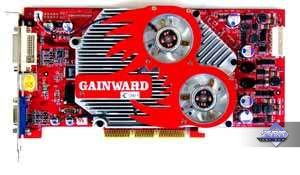 |
| Comparison with the reference design, back view
|
| Gainward FX Powerpack Ultra/1200 Golden Sample |
Reference card NVIDIA GeForce FX 5900 |
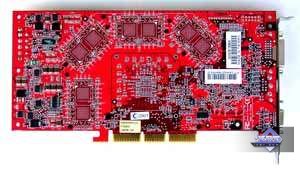
|

|
|
Here
are some aspects to be pointed out:
1. The new FX5900 design differs a little from the reference 5900 Ultra card,
- the right section that controls the power supply is redesigned. 2. The memory
size was cut down from 256MB to 128MB - on the backside there are empty space
for missing BGA chips. But the 256bit bus wasn't shortened because the card has
8 32bit memory chips (256 bits in all). The card just doesn't support the dual-bank
memory mode.
Now, please, have a look at the cooler.
| Gainward FX Powerpack Ultra/1200 Golden Sample |
|
This is a massive aluminum heatsink equipped with two fans and LEDs for illumination.
Such cooler is pretty effective in spite of a single heatsink for the memory
and GPU. But the memory doesn't generate much heat (for 2.2ns memory the clock
speed of 425 MHz is not that high), the heat generation of the NV35 is significantly
reduced, and too complicated coolers are not needed.
If video cards were installed with their coolers on top and PC cases were transparent,
the LEDs could have a real effect. But the LEDs illuminate only what's under them.
|

|
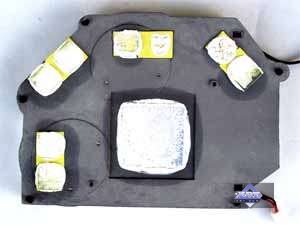
|

|
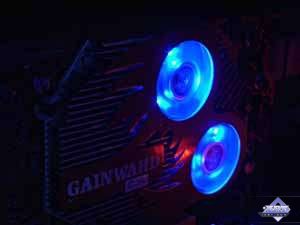
|
The card is equipped with the Philips 7114 codec to control the Video-In. The
TV-out is supported by the NV35 itself. Here it is:
This product was released on the 18th week of this year (beginning of May), i.e.
before the GeForce FX 5900 was announced. Hence the codename.
The box contents:
|
| Gainward FX Powerpack Ultra/1200 Golden Sample |
|
User guide, CD with drivers and utilities, VIVO software, S-Video-to-RCA and
DVI-to-d-Sub adapters, a VIVO splitter, and an external power supply adapter.
|
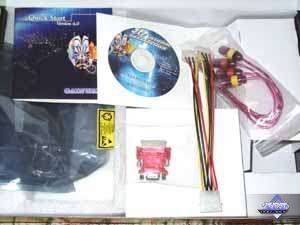 |
|
The card ships in the retail package.
|
| Gainward FX Powerpack Ultra/1200 Golden Sample |
| This is a stylish box in the style of the latest cards. |
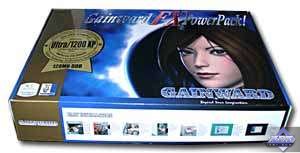 |
Testbed and drivers
Testbed:
- Pentium 4 3200 MHz based computer:
- Intel Pentium 4 3200 MHz CPU;
- DFI LANParty Pro875 (i875P) mainboard;
- 1024 MB DDR SDRAM;
- Seagate Barracuda IV 40GB HDD;
- Windows XP SP1; DirectX 9.0a;
- ViewSonic P810 (21") and ViewSonic P817 (21")
monitors.
- NVIDIA drivers v44.65.
VSync off, S3TC off in applications.
Cards used for comparison:
- Reference card NVIDIA GeForce FX 5900 Ultra (450/425 (850) MHz, 256 MB);
- Hercules 3D Prophet 9800 PRO (RADEON 9800 PRO, 380/340 (680) MHz, 128 MB,
driver 6.360).
Overclocking
|
|
Gainward FX Powerpack Ultra/1200 Golden Sample
|
400/850 -> 470/960 MHz (excellent!)
|
|
Note
that
Overclocking requires additional card cooling (for its memory, in particular):
Overclocking depends on a certain sample, and you shouldn't extend single-card
results to the entire series or trade mark. Overclocking results are not obligatory
characteristics of video cards.
Test results
Before we start examining 2D quality, I should say there are no complete techniques
for objective 2D quality estimation because:
- 2D quality much depends on certain samples for almost all modern 3D accelerators;
- Besides videocards, 2D quality depends on monitors and cables;
- Moreover, certain monitors might not work properly with certain video cards.
As for the samples tested, together with the ViewSonic P817 monitor and BNC
Bargo cable they showed excellent quality at the following resolutions and clock
speeds:
|
|
Gainward FX Powerpack Ultra/1200 Golden Sample
|
1600x1200x85Hz, 1280x1024x120Hz, 1024x768x160Hz (perfect!)
|
Test
results: comparison of the cards' performance
Conventional signs: ANISO 8xP - Anisotropic 8x Performance (earlier it was
called Balanced), ANISO 8xQ - Anisotropic 8x Quality, ANISO 16xQ - Anisotropic
16x Quality.
Test applications:
- Return to Castle Wolfenstein (MultiPlayer) (id Software/Activision) - OpenGL,
multitexturing,ixbt0703-demo, test settings - maximum, S3TC OFF, the configurations
can be downloaded from here
- Serious Sam: The Second Encounter v.1.05 (Croteam/GodGames) - OpenGL, multitexturing,ixbt0703-demo,
test settings: quality, S3TC OFF
- Quake3 Arena v.1.17 (id Software/Activision) - OpenGL, multitexturing,ixbt0703-demo,
test settings - maximum: detailing level - High, texture detailing
level - #4, S3TC OFF, smoothness of curves is much increased through
variables r_subdivisions "1" and r_lodCurveError
"30000" (at default r_lodCurveError is 250 !), the configurations
can be downloaded from here
- Unreal Tournament 2003 v.2225 (Digital Extreme/Epic Games) - Direct3D, Vertex
Shaders, Hardware T&L, Dot3, cube texturing, default quality
- Code Creatures Benchmark Pro (CodeCult) - the game that demonstrates card's
operation in DirectX 8.1, Shaders, HW T&L.
- Unreal II: The Awakening (Legend Ent./Epic Games) - Direct3D, Vertex Shaders,
Hardware T&L, Dot3, cube texturing, default quality
- RightMark 3D v.0.4 (one
of the game scenes) - DirectX 8.1, Dot3, cube texturing, shadow buffers, vertex
and pixel shaders (1.1, 1.4).
Note that the Anti-Detect is applied
only to the Direct3D applications, the OpenGL games have simply changed their
demo benchmarks.
Quake3 Arena
The tests with the new demo benchmark show that the FX 5900 takes the lead
only in the modes with the AA and anisotropy disabled and in the Performance mode
with the anisotropic filtering used. But taking into account the way of realization
of anisotropy in the RADEON 9800 PRO, the maximum level of the ATI's products
can be compared to the Performance level (former Balanced) of the NVIDIA's solutions.
Serious Sam: The Second Encounter
The FX 5900 loses the battle, though the performance gap is not that great.
Return to Castle Wolfenstein (Multiplayer)
Like in the Quake3, the NVIDIA wins only in the ANISO Performance mode (but
it seems that the CheckPoint demo benchmark wasn't ignored by the guys at NVIDIA,
and the FX 5900 had much higher scores than now).
Code Creatures
First off, the cheat detection revealed that NVIDIA did its "best"
and raised the speed by 30%. Besides, without such cheats the FX 5900 would suffer
a crushing defeat (that was expected because the Code Creatures aggressively use
shaders). Unfortunately, it's impossible to take two identical screenshots here
(this is a rolling demo, without interactive support), that is why we can't compare
quality with the cheats and without. But even if there are some useful optimizations
that boost performance without damaging quality, they could make sense only if
this application were a game. But this is a benchmark (even though it's built
on the game engine), and it's not fair to make changes and make this test work
differently from what was planned by its developers. I must say that we found
no cheats in ATI's RADEON for this test!
Look at the anisotropic filtering in this test! As there is no speed drop,
this function doesn't work! So attractive figures demonstrated by the card in
comparison with the RADEON 9800 PRO are wrong. Although it's not a direct evidence
of the fact that anisotropy doesn't work here, this function is never costless.
Unreal Tournament 2003
The FX 5900 fails again. The Anti-Detect also shows that the cheats increase
the speed by 23-37% on the standard benchmark DM-Antalus FlyBy! The RADEON 9800
PRO reveals no cheats again!!! It refers both the the standard test DM-Antalus
and our demo.
However, some of NVIDIA's optimizations are useful: just compare the performance
with the Anti-Detect and without it on our demo benchmark (not the standard one).
Since it's impossible to make cheats for our demo version, the difference is caused
by useful optimizations which were disabled by the Anti-Detect. Below are several
pictures that prove that the quality is the same with the AD and without (but
completely identical screenshots can't be attained for per-pixel comparison because
the game uses random actions).
ATTENTION! The full-size screenshots are recorded in the BMP format!
EACH SCREENSHOT MEASURES 2.3 MB and packed into a RAR archive of about 1 MB!
|
| Driver 44.65, Anti-Detect |
Driver 44.65, no Anti-Detect |
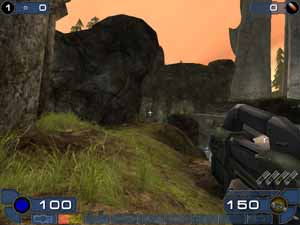
|
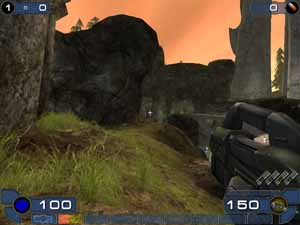
|
Unreal
II: The Awakening
The picture for the FX5900 is pretty sad. Fortunately, no cheats were found
this time (probably because this game has no standard benchmarks :-) ).
RightMark 3D
The most shader-intensive test raveled how weak the FX 5900 is in this respect.
Fortunately, none of the companies brought in cheats for our test :-), though
after this review they can take revenge.
|
Conclusion
So, if the previous tests based on the standard demo benchmarks or games included
in the standard packets showed that the GeForce FX 5900 had a good chance to beat
the RADEON 9800 PRO, the elimination of the cheats by replacing the standard demo
benchmarks with specially developed ones revealed that the FX 5900 is not that
good.
Although the difference is not fatal, the tests that intensively use shaders
show that the RADEON 9800 PRO has better prospects than the FX 5900. As to the
tests like Quake3 or RtCW, the scores so pleasant for fans of NVIDIA faded away.
The reason is again the cheats (though without an Anti-Detect for OpenGL we can't
provide the uncontradicted evidence).
However, the card we are dealing with is based on the FX 5900 Golden Sample!
That is why its clock speeds can be lifted up to the level of the 5900 Ultra without
the risk of misoperation! The scores change a little, but it hardly affects the
shader performance.
A strong point of many GeForce FX 5900 based cards is very attractive accessory
packs. In contrast, the ATI partners usually simply stick their logos to reference
cards, add a CD, a couple of cables and an adapter. Or they simply sell cards
as OEM versions. I think they should take lessons from MSI, Triplex, ASUS, Albatron,
Gainward how represent their products. Many of those users who are ready to pay
$400-430 for a great accelerator would thus prefer the GeForce FX 5900 even in
spite of its lower speeds and drivers with cheats.
So, the Gainward FX Powerpack Ultra/1200 Golden Sample can offer you:
- A very high performance in 3D graphics, equal to that of the RADEON 9800
PRO mostly in the AA and anisotropy modes (the prices are equal at that);
- Amodern technological solution with the DX9 support (such games are right
around the corner already), though the shader performance is inferior to the ATI's
cards;
- VIVO support.
But it's actually a matter of taste: someone prefers shaders, another wants
a beautiful card with a high performance in modern games. Besides, it's still
unknown how future DX9 games will look like. Also one should remember that the
NV3x is very flexible, which potentially gives a chance to the NV35 to look not
worse than its competitor in such applications. I also wish the prices for the
FX 5900 were adequate (lower than those of the RADEON 9800 PRO to increase demands).
It's clear that the GeForce FX 5900 Ultra can't be called a single 3D king
(the difference between the 5900 and 5900 Ultra is demonstrated above, so you
can estimate whether the 5900 Ultra is able to outscore even the 128MB version
of the RADEON 9800 PRO). We admit that we were wrong giving the crown to the new
NVIDIA product because of the deceitful 3DMark scores. The throne is now shared
by two GPUs, but the prices for the High-End products become higher at the beginning
of sales. Isn't it strange?
In our 3Digest you can find full comparison characteristics for video cards
of this and other classes.
Write a comment below. No registration needed!
|
|
 |
|
|
|
